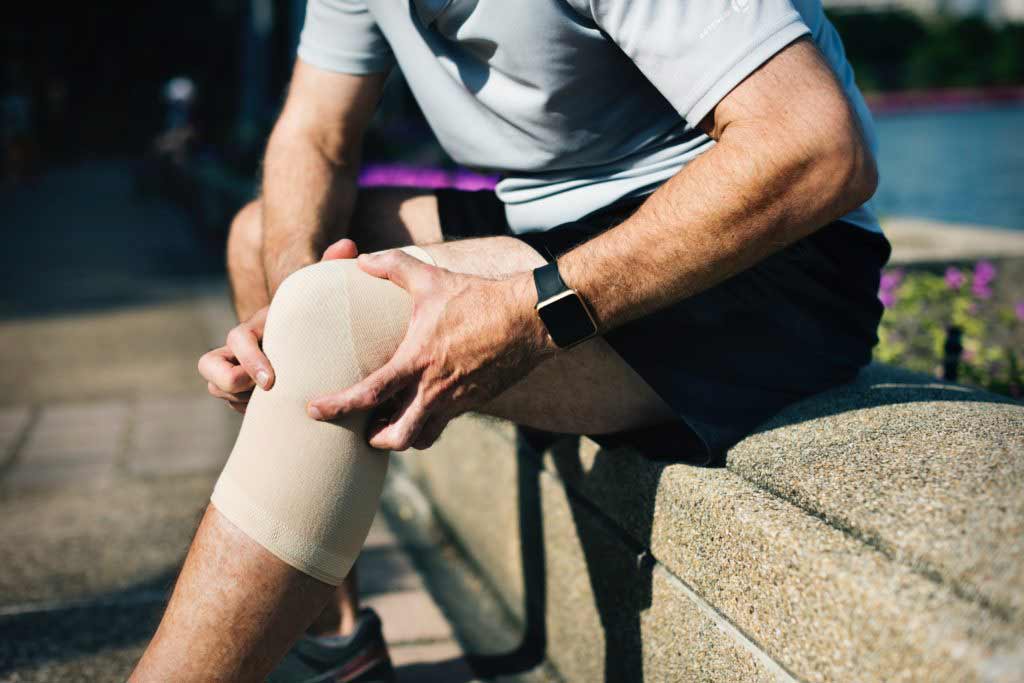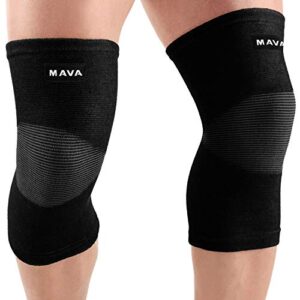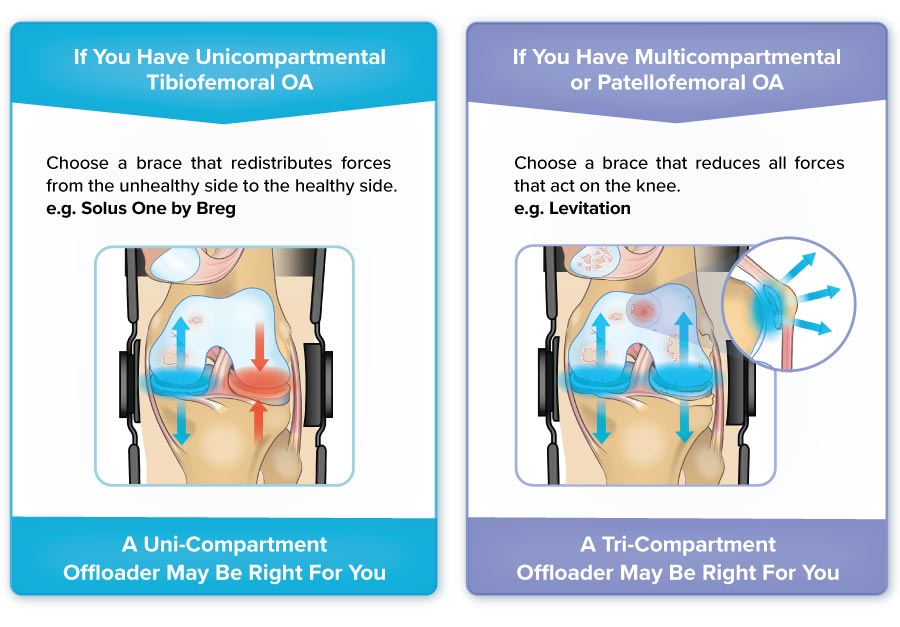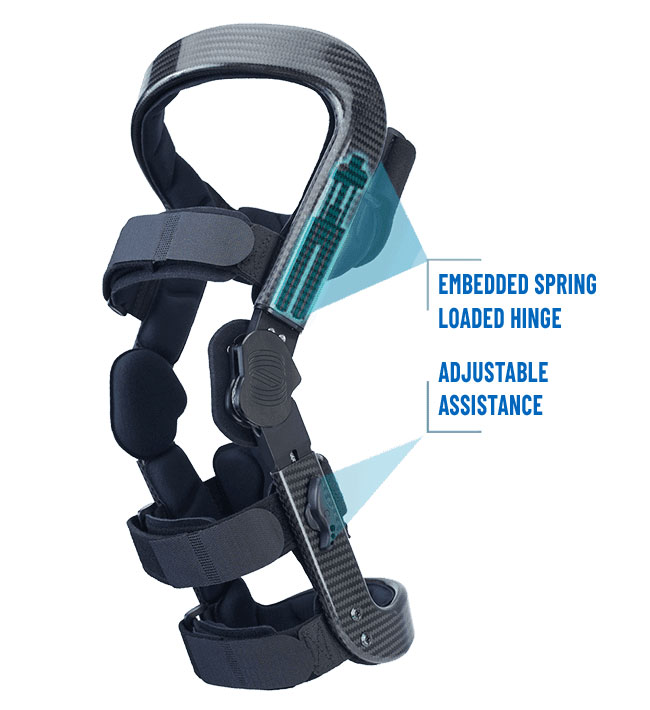All About The Compression Knee Brace

A compression knee brace is a sleeve worn around the knee joint. Also known as a compression sleeve or knee sleeve, this product can be worn for added stability, protection, and pain relief. Other benefits of this brace include added warmth and increased proprioception, which is the body’s awareness of itself.
These sleeves are made largely of cloth, neoprene, or another moisture-wicking material. They may also include cut-outs around the kneecap for keeping it in place. Their simple structure is what distinguishes them from true knee braces. In contrast, a true knee brace contains hinges and sometimes bars for added structure.
Check out The Best Hinged Knee Brace For Your Condition to understand the variety of hinged knee braces on the market.
What Does A Compression Knee Brace Do?
Compression braces are usually used in combination with other treatments, particularly physical therapy1, or for preventative reasons. Compact and lightweight, they can be easily worn during sports or while performing physical therapy.

These braces may have heat retaining properties, which can increase blood flow and provide warmth to the joint. Improved circulation, as well as heat, are considered beneficial since they are thought to prevent injury and relieve pain2.
Compression braces, as their name implies, may also offer some stability by compressing the area. If you have patellofemoral knee pain, a compression brace with cut-outs or buttresses may be useful for the additional security it applies to the kneecap3. These cut-outs are intended to keep the patella in place and tracking properly in its groove.
Do Compression Knee Braces Work?
Research findings on the effectiveness of compression knee braces have been mixed. Some studies have found compression braces to improve pain, gait, and balance for individuals with knee osteoarthritis1,4. However, another study has shown that these braces only offer small amounts of pain relief and only during the short term5.
Because compression braces are thought to retain body heat, they may prevent injury during movement and offer some pain relief2. A compression brace may also help you be more aware of your body positioning6, which can be useful if you perform high-risk or physically taxing activities.
Based on the state of research on these braces today, it seems likely that they can offer functional improvements in aspects like gait, balance, and proprioception3. However, the current state of research still has lots of room for improvement. To fully confirm the benefits of compression braces, more research needs to be conducted.
Will A Compression Knee Brace Help Me?
In general, if your condition is mild, a compression knee brace may be helpful. Some people wear compression braces to prevent injury. You may also find this brace useful if you are healing from a minor condition, such as mild tendon swelling or minor patellar misalignment. However, compression braces will likely not offer enough pain relief and stability to more severe conditions.
Below are potential benefits of compression bracing for a range of activities and conditions.
High-Risk or High-Intensity Activities
Compression knee braces may offer some joint protection due to their ability to increase your proprioception. Proprioception is your awareness of your body positioning, which impacts your motor control.
Generally, proprioception decreases as you become more fatigued. For example, at the end of a soccer match or run when your body is tired, you will have less control and awareness over your movements. In the case of injury prevention, knowing this connection is useful. Injuries are more likely to happen when you feel fatigued, partly because that is when you have less control over your movements.
Compression knee braces may be useful during these periods of fatigue, since have been found to increase proprioception during these occasions6. So if you participate in high-risk or high-intensity activities, wearing a compression brace may be helpful. Additionally, if you generally have a poor sense of body positioning, a compression brace may help your motor control even before you become fatigued6.
Pain During Weight-Bearing Activities
Weight-bearing activities include squatting, going up and down the stairs, and rising from a seated position. If you experience pain doing these activities, you may have patellofemoral knee pain. This condition originates from underneath the kneecap (patella).

If your patellofemoral knee pain is caused by misalignment or minor swelling of your tendons, a compression knee brace may help you. By keeping your patella aligned, increasing body heat and proprioception, this brace can help you heal. Additionally, a compression brace can help prevent further wear and tear of your patellofemoral joint.
However, if your patellofemoral knee pain is caused by a degenerative condition, such as osteoarthritis, you may want a sturdier brace. This is because cartilage degeneration will cause bone-on-bone rubbing, which is a painful condition prone to worsening over time. When the bones of your knee joints rub, you may prefer a hinged brace that can offload the pressure within your joint.
- Bone on Bone Knee Pain – What You Need to Know
- The Best Knee Braces for Pain
- The Best Brace for Bone on Bone Pain
Chronic Patellofemoral Pain
There is a lack of evidence for compression braces in treating chronic patellofemoral pain7. Based on the simple structure of this brace, this finding makes sense. These braces will not be able to sufficiently offload pressure from the patellofemoral compartment.
However, you may be able to find relief from a tri-compartment offloader, like the Levitation knee brace. Tri-compartment offloaders are hinged braces proven to provide pain relief for patellofemoral osteoarthritis8, among many other conditions.
ACL Injury or Prevention
While compression braces may prevent patellofemoral conditions from getting worse, they likely cannot prevent ACL injuries. A recent study found compression braces unable to provide adequate protection during drop jump tests9. In these tests, compression braces did not limit shear force and internal rotation within the knee. Shear force and internal rotation are two forces that stress the ACL.
It is also unclear if compression braces can improve your gait if you have an injured or weakened ACL3. In other words, we can’t yet say whether a compression brace can help ACL-deficient knees while walking or running. However, silicone compression braces have been shown to help with body positioning, balance, and muscle strength in patients after ACL reconstruction10.
Conditions With Severe Knee Instability
Compression knee braces offer less structural support than a hinged knee brace. As a result, they will not be the most suitable product for treating knee conditions with lots of instability. For example, if you suffer from severe knee osteoarthritis or another highly destabilizing joint condition, you may want something with more stability.
That being said, research has shown that compression braces can improve gait, balance, and pain in people with knee osteoarthritis1,4. So if your case is mild, a compression brace may be a good option for you. In addition, it is more cost-effective to try a compression brace before buying a hinged brace. If you find that your compression brace does not satisfactorily treat your osteoarthritis symptoms, you can always upgrade to a hinged brace.
Compression Knee Brace Alternatives
Thankfully, many hinged knee braces offer the benefits of compression while also providing higher levels of stability and pain relief. If your condition is still fairly mild, but you’d like more support from your brace, you can also look for a compression brace with polycentric hinges. An example of this type of brace is this knee brace by McDavid.
If you have osteoarthritis and are looking for a hinged knee brace that can offload, you have two choices. Your first option is a uni-compartment offloader. Your second option is a tri-compartment offloader.

Uni-compartment offloaders are typically used for treating osteoarthritis in one side of the knee. They work by redistributing force across the knee from one side compartment to the other. Tri-compartment offloaders, on the other hand, work for all patterns of osteoarthritis, as well as other conditions. Due to their ability to offload the entire knee, these braces have successfully treated ligament and meniscus injuries of the knee as well.
- Choosing a Knee Brace: Everything You Need to Know
- Top Five Offloaders on the Market
- The Best Brace for Meniscus Tears
Levitation: World’s First Tri-Compartment Offloader
The Levitation knee brace is what’s known as a tri-compartment offloader. What does this mean? Tri-compartment offloading refers to the ability to reduce pressure in all three knee compartments. No other knee brace on the market is capable of doing this action. Uni-compartment offloaders are the only brace that comes close, but they can only reduce pressure on one side of your knee.

As a result of its offloading capabilities, Levitation is an effective brace for a variety of knee conditions. Since it can offload the patellofemoral compartment, this brace can treat patellofemoral knee pain and patellofemoral osteoarthritis. This brace has also successfully treated osteoarthritis in multiple compartments, as well as ligament and meniscus injuries.
References
- Bryk, F. F., Jesus, J. F. de, Fukuda, T. Y., Moreira, E. G., Marcondes, F. B., & Santos, M. G. dos. (2011). Immediate effect of the elastic knee sleeve use on individuals with osteoarthritis. Revista Brasileira De Reumatologia, 51(5), 440–446. https://pubmed.ncbi.nlm.nih.gov/21952996/
- Mazzuca SA., et al. “Pilot study of the effects of a heat-retaining knee sleeve on joint pain, stiffness, and function in patients with knee osteoarthritis.” Arthritis Rheum. 2004 Oct 15;51(5):716-21. Accessed October 22nd 2014.
- N. A. Mohd Sharif, S.-L. Goh, J. Usman, and W. K. Z. Wan Safwani, “Biomechanical and functional efficacy of knee sleeves: A literature review,” Physical Therapy in Sport, vol. 28, pp. 44–52, Nov. 2017, doi: 10.1016/j.ptsp.2017.05.001.
- Mazzuca S, Page MC, Meldrum RD, Brandt KD, Petty-Saphon S. Pilot study of the effects of a heat-retaining knee sleeve on joint pain, stiffness, and function in patients with knee osteoarthritis. Arthritis Rheum 2004;51:716–21. https://doi.10.1002/art.20683
- Pajareya, K., Chadchavalpanichaya, N., & Timdang, S. (2003). Effectiveness of an elastic knee sleeve for patients with knee osteoarthritis: A randomized single-blinded controlled trial. Journal of the Medical Association of Thailand = Chotmaihet Thangphaet, 86(6), 535–542. https://pubmed.ncbi.nlm.nih.gov/12924802/
- D. Van Tiggelen, P. Coorevits, and E. Witvrouw, “The use of a neoprene knee sleeve to compensate the deficit in knee joint position sense caused by muscle fatigue: Deficit in knee joint position sense,” Scandinavian Journal of Medicine & Science in Sports, vol. 18, no. 1, pp. 62–66, May 2007, doi: 10.1111/j.1600-0838.2007.00649.x.
- M. Hrubes and T. L. Nicola, “Rehabilitation of the Patellofemoral Joint,” Clinics in Sports Medicine, vol. 33, no. 3, pp. 553–566, Jul. 2014, doi: 10.1016/j.csm.2014.03.009.
- Budarick, A.R., Bishop, E.L., and Cowper-Smith, C.D. (2021). Preliminary evaluation of a new orthotic for multi-compartment knee osteoarthritis: a retrospective pilot survey. J. Prosthet. Orthot. Under Peer Review.
- Moon, J., Kim, H., Lee, J., & Panday, S. B. (2018). Effect of wearing a knee brace or sleeve on the knee joint and anterior cruciate ligament force during drop jumps: A clinical intervention study. The Knee, 25(6), 1009–1015. https://doi.org/10.1016/j.knee.2018.07.017
- Kwon H, Park D, Jeong JR, Jung K. The effect of silicone sleeve and taping on balance and strength in anterior cruciate ligament reconstruction patients. J Korean Soc Phys Ther 2014;26:147–55.